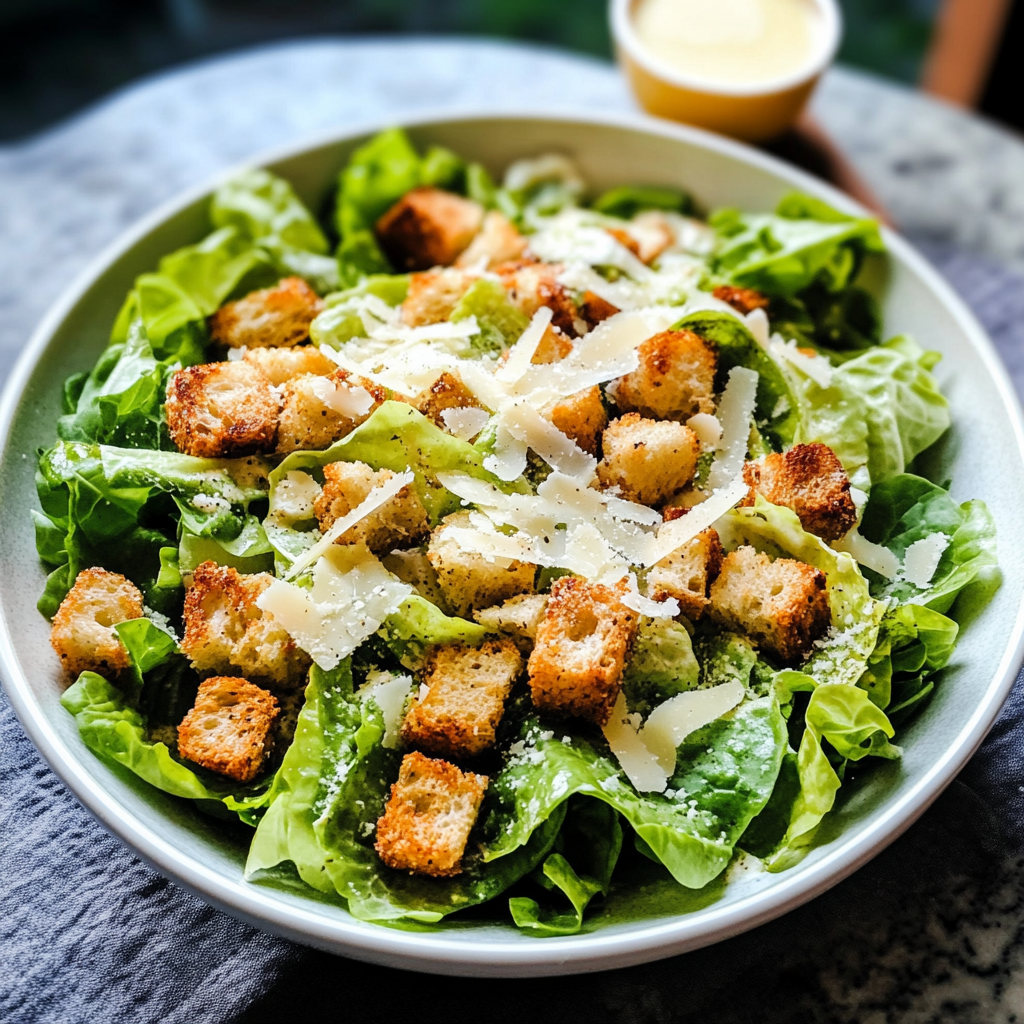There’s something timeless about a well-made Caesar salad. With crisp romaine, crunchy garlic croutons, and a luxuriously creamy dressing made from scratch, this dish embodies both comfort and sophistication. The tangy kick from lemon juice and the umami depth from Parmesan and garlic balance beautifully, making it far more than just a side dish.
Perfect for lunch, dinner, or as a starter to any hearty meal, this Caesar Salad is incredibly easy to whip up yet feels gourmet. It’s a great way to show your love through food, especially when you make the dressing by hand. Ditch the bottled stuff—you deserve better. This salad delivers restaurant-quality flavor right at home.
Full Recipe
Ingredients:
For the Salad:
-
1 large head of romaine lettuce, chopped
-
1/2 cup freshly grated Parmesan cheese
-
1 cup garlic croutons
For the Caesar Dressing:
-
1 egg yolk (room temperature)
-
1 teaspoon Dijon mustard
-
2 tablespoons lemon juice (freshly squeezed)
-
1 teaspoon Worcestershire sauce
-
2 garlic cloves, minced
-
1/4 cup grated Parmesan cheese
-
1/2 cup avocado oil (or light olive oil)
-
Salt and black pepper, to taste
Directions:
-
In a bowl, whisk together egg yolk, Dijon mustard, lemon juice, Worcestershire sauce, and minced garlic until creamy and well combined.
-
Slowly drizzle in the oil while continuously whisking until the dressing emulsifies and thickens.
-
Stir in 1/4 cup grated Parmesan cheese and season with salt and black pepper to taste.
-
In a large salad bowl, toss the chopped romaine with the prepared Caesar dressing until evenly coated.
-
Add the croutons and remaining Parmesan cheese on top.
-
Serve immediately for the best crunch and flavor.
Prep Time: 10 minutes | Cooking Time: 0 minutes | Total Time: 10 minutes
Kcal: 310 kcal | Servings: 4 servings
The Timeless Appeal of a Classic Caesar Salad
Few dishes carry the same level of elegance, simplicity, and widespread appeal as the Caesar salad. Whether served as a light starter or paired with a protein for a full meal, this salad has long been a staple in both home kitchens and high-end restaurants. The Caesar salad’s genius lies in its balance—crisp, refreshing romaine lettuce meets a creamy, tangy, umami-rich dressing that’s anchored by garlic, anchovy (optional), lemon juice, and Parmesan cheese. Add crunchy croutons, and you have a texture and flavor profile that’s universally loved.
The Origins of Caesar Salad
Contrary to what many believe, the Caesar salad wasn’t named after Julius Caesar or connected to Italy. Instead, it was created by Caesar Cardini, an Italian-American restaurateur, in the 1920s in Tijuana, Mexico. During Prohibition, many Americans crossed the border to enjoy alcohol in Mexican restaurants, and it was during one such evening rush that Cardini supposedly improvised the original Caesar salad using ingredients he had on hand. Over time, the salad gained popularity for its bold flavors and showy tableside preparation.
Why Homemade Dressing Matters
One of the most crucial elements of a great Caesar salad is the dressing. While many opt for bottled varieties for convenience, they often miss the complex and nuanced flavor that comes from making the dressing fresh. Homemade Caesar dressing is creamy and rich, with a perfect blend of garlic, lemon, egg yolk, Dijon mustard, and grated Parmesan. Avocado oil or a light olive oil binds it all together, creating an emulsified texture that clings beautifully to the lettuce. When made correctly, the dressing should be tangy, savory, slightly salty, and utterly satisfying—without overpowering the other components of the salad.
Egg Yolk in Caesar Dressing: Safe and Delicious
A traditional Caesar salad dressing uses raw egg yolk to create its signature creaminess. This can raise safety concerns for some, but using high-quality, fresh eggs or pasteurized eggs mitigates the risk of salmonella. The richness that egg yolk brings to the dressing is unmatched—it helps emulsify the oil and other acidic components into a smooth, luxurious texture. It’s also what differentiates homemade dressing from its processed counterparts, which often rely on mayonnaise or other thickeners.
The Role of Parmesan Cheese
Parmesan cheese adds a punch of umami and saltiness to both the dressing and the salad itself. Freshly grated Parmesan is a must here—avoid pre-shredded or canned versions, which lack the depth and melt-in-the-mouth texture of authentic Parmigiano-Reggiano. In the dressing, it adds body and enhances flavor. Sprinkled over the salad, it finishes the dish with a nutty, sharp edge that complements the tangy dressing and fresh lettuce.
Croutons: The Crunch Factor
A Caesar salad would not be complete without croutons. They bring texture, crunch, and substance, elevating the salad from a simple side dish to a satisfying meal. Homemade garlic croutons are particularly special; they’re easy to prepare and absorb the flavors of the oil and seasonings they’re tossed with. When freshly toasted, they provide a delightful contrast to the tender lettuce and creamy dressing. For those who are gluten-free, there are many ways to create suitable crouton alternatives using gluten-free bread or even crispy chickpeas.
Romaine Lettuce: The Ideal Green
The base of a Caesar salad, romaine lettuce, is chosen for its sturdy texture and refreshing bite. Unlike more delicate greens, romaine holds up well to the weight of the dressing and the other toppings. Its crispness is crucial in balancing the creamy dressing and providing a satisfying chew. When preparing romaine, it’s essential to wash and dry the leaves thoroughly. Wet lettuce can dilute the dressing and result in a soggy salad.
Variations and Customizations
Although the classic Caesar salad is beloved for its simplicity, it’s also a versatile base for numerous additions. Grilled chicken, shrimp, salmon, or even steak can be added to turn the salad into a protein-rich entree. For vegetarians, roasted chickpeas or tofu make excellent protein substitutes. If you’re avoiding eggs or anchovies, there are vegan Caesar dressing recipes that use cashews, tahini, or avocado for creaminess and capers or soy sauce to mimic the salty depth of anchovies.
The dressing can also be customized to suit your palate—add a bit of anchovy paste for extra umami, a touch of honey for sweetness, or more garlic for a punchier profile. Caesar salads can also be made heartier by mixing in kale or adding grains like quinoa or farro.
Tips for the Perfect Caesar Salad at Home
Achieving a restaurant-quality Caesar salad at home is easier than it seems. A few key tips include:
-
Chill your lettuce. Cold, crisp lettuce makes the salad more refreshing and helps the dressing stick.
-
Emulsify your dressing slowly. Pour the oil in a thin stream while whisking to ensure a creamy consistency.
-
Use fresh ingredients. From garlic to Parmesan, fresh components dramatically improve flavor.
-
Toss gently but thoroughly. Coat every piece of lettuce evenly without bruising the leaves.
-
Serve immediately. Caesar salad is best enjoyed right after it’s made, before the croutons lose their crunch and the lettuce wilts.
Nutritional Benefits of Caesar Salad
While Caesar salad may not always be considered a health food—especially when loaded with cheese and croutons—it can be a nutritious meal when made mindfully. Romaine lettuce is high in vitamin A, vitamin K, and folate. The egg yolk provides healthy fats and choline, while the oil contributes heart-healthy monounsaturated fats, especially when you use avocado oil. Adding lean protein boosts the nutritional profile further, making it a balanced and satisfying meal option.
For those watching their calorie intake, reducing the amount of oil and cheese, or using a light hand with the croutons, can help make the dish lighter without sacrificing flavor. Alternatively, turning the salad into lettuce wraps or stuffing it into whole grain pita pockets is a fun way to control portions.
Why It’s Worth Making from Scratch
In a world full of processed foods and shortcuts, making a Caesar salad from scratch feels like a return to real cooking. It takes just a few extra minutes but offers incredible returns in flavor, texture, and satisfaction. You control every ingredient that goes into the bowl—from the freshness of the lettuce to the intensity of the garlic in the dressing. Plus, making your own salad dressing eliminates additives, preservatives, and unnecessary sugars often found in store-bought varieties.
Conclusion
A classic Caesar salad is more than just a side dish—it’s a celebration of fresh ingredients, balanced flavors, and simple culinary technique. With crisp romaine, a creamy homemade dressing, sharp Parmesan, and crunchy croutons, every bite delivers on flavor and texture. While the recipe may be decades old, it remains a timeless favorite that can be adapted, upgraded, or enjoyed exactly as it was originally intended. Whether you’re serving it for a casual lunch, a dinner party, or a solo weeknight meal, this Caesar salad is a guaranteed crowd-pleaser.
By investing a little time in making it from scratch, you’re not only elevating your dining experience—you’re also honoring a piece of culinary history that continues to earn its place on the world’s best menus. So, pull out your whisk and prepare to fall in love all over again with one of the most iconic salads ever created.






